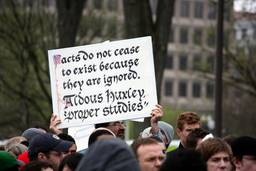This weekend, tens of thousands angry “Tea Party” protesters (not two million, the figure right-wing bloviators have concocted) denounced the “socialism” of the Obama administration and the President’s healthcare plan.
Some, but hardly all, of the protesters—fueled by Fox News disinformation and mobilized in part by corporate front groups — displayed even uglier invective against Obama, calling him a terrorist and likening him to Hitler.
Yet on Sunday, a different vision of America was unveiled: the AFL-CIO started its convention in Pittsburgh with the goal of creating an economy and government that works for everyone. The contrast with the protest in Washington couldn’t have been more stark.
Both mainstream journalists and leading bloggers have differed over how much a role racism has played in driving conservative attacks on the president. But from what I saw when observing the rally on the Capitol’s West Lawn (see C-SPAN video for full coverage), something more politically ominous was at work than overt racism amid the sea of yellow flags with the “Don’t Tread on Me” symbol of a segmented snake.
Kooky racists can be easily marginalized and dismissed by progressives, but that’s not the political danger to a progressive and labor agenda the protesters actually pose.
Instead, it’s the not-so-veiled hostility to the notion of virtually any government role in American society (outside of war and policing), and the resistance to taxation and “Big Government.”
The Nixonian politics of resentment laid the groundwork for the anti-big government crusade of President Ronald Reagan that still shapes our political debates — while the notion of government-as-villain dominating GOP politics today was fueled decades ago largely by racially-tinged hatred of social welfare programs.
Rush Limbaugh has updated this racist fear-mongering by casting President Obama’s efforts to cushion the blow of the recession through expanded food stamps and extended unemployment benefits as “forced reparations.”
Most of the time, though, hostility to government spending and taxes is disguised, even to many conservative protesters themselves, as a legitimate concern about dangerous deficits and the long-term debt burdening their grandkids. But the alarm about trillions in spending and ballooning deficits didn’t seem to bother the right-wing during the Bush era when needless Iraq war costs and massive tax cuts to the wealthy were involved.
The convoluted dynamics involved in the protest were underscored by my brief interview with some middle-aged and elderly Mississippi residents. They were wearing, of all things, orange T-shirts calling themselves “Mississippi Freedom Riders,” well aware that that was the name for civil rights activists in the ’60s who risked their lives to end state-sanctioned segregation and who called for federal intervention, helping spur often-violent Southern resistance to integration.
Now, Cindy Wilkerson of Laurel, Miss., a former hospice worker, told me, “We’re riding for freedom, the freedom not to be taxed.” And she denounced Obama’s healthcare plan as setting a “precedent to give the government a stepping-stone” to kill the elderly — and as “socialist.”
There were so many sick ironies at work here it was hard to keep track of them all. The Southern revolt against Democratic-led civil-rights legislation, the need for which was dramatized by sit-ins, dogs attacking blacks marching for civil rights, children bombed in churches and “Freedom Riders” facing howling mobs at bus stations, helped build the base for the modern GOP. Perhaps the most virulent opposition to civil rights was found in Mississippi (hear Nina Simone sing “Mississippi Goddamn” here.)
Later, hatred and fear of blacks, and any government social services for them, helped inspire the first wave of tax revolts, including Proposition 13 in the late 1970s in California. And now a new wave of tax protesters was in the nation’s capital, including a contingent from Mississippi daring to call themselves “Freedom Riders” and venting their rage at the country’s first African-American president — and his efforts to secure healthcare for all citizens.
In sharp contrast, the first day of the AFL-CIO convention in Pittsburgh on Sunday was devoted in part to promoting diversity in the workplace and in unions, including leadership roles. There will also be an array of high-profile leaders expected to address the convention this week, including President Obama, Caroline Kennedy, Labor Secretary Hilda Solis and incoming AFL-CIO president Richard Trumka.
UPDATE: On Monday, Labor Secretary Hilda Solis gave an impassioned speech in support of workers’ rights and the importance of unions for social reforms. And she gave the strongest signal yet that she would “work hard” to get the Employee Free Choice Act passed:
But just as important are the voices of delegates to the convention, including Ohio union leader Petee Talley, who highlighted the importance of local grassroots organizing for passing a true freedom agenda very different than that of the “Tea Party” protesters: the freedom to have access to affordable healthcare and the freedom to organize a union under the Employee Free Choice Act. Here’s how she expressed what’s at stake in Pittsburgh this week:






